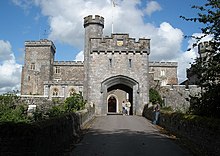Powderham Castle
Powderham Castle is south of the English city of Exeter in Devon . The associated property extends to the west side of the mouth of the River Exe between the towns of Kenton and Starcross .
Powderham Castle was built between 1390 and 1420 by Sir Philip Courtenay (1355-1406), a son of Hugh de Courtenay, 2nd Earl of Devon of the Courtenay family , and is still owned by his descendants, Courtenay of Powderham , who since 1831 the head of which has held the title of Earl of Devon since 1831 . Sir Philip's mother, Margaret de Bohun, daughter of Humphrey de Bohun, 4th Earl of Hereford and Elizabeth de Plantegenet, daughter of King Edward I , had brought the Powderham estate into the possession of the Courtenay family in 1325 as a dowry, on which the coat of arms of the Bohun family on the inside of the gate.
The building has the long hall floor plan typical of the Middle Ages with six towers, but only one of them is still standing. In the 18th and 19th centuries, the building was changed and expanded, most sustainably in the 1790s by the important architect James Wyatt . Today's access through the gate, the courtyard and the great hall dates back to the 19th century at the time of William Courtenay, 10th Earl of Devon . His coat of arms and that of his wife, Lady Harriet Pepys-Leslie, can be seen above the archway in the courtyard. She was the daughter of King George III's court doctor . , Sir Lucas Pepys, 1st Baronet, and Jane Leslie, 12th Countess of Rothes .
From the knight's hall, the visitor arrives through the first library, the music room, the second library, the porcelain room and the stairwell and finally into the marble hall, which is the most interesting room in terms of architectural history and furnishings. It still has the three entrances from 1390 that led to the kitchen and pantry. The furnishings include a 17th century Brussels tapestry; part of the wallpaper is from the same period. The grandfather clock from around 1740 comes from the workshop of the famous watchmaker William Stumbels in Totnes ; the wooden family coat of arms dates back to 1553. There are a number of portraits on the walls of members of the Courtenay family who were part of the history of England in various ways.
Finally, the chapel is to be seen, which is housed in a building from the 15th century and which was consecrated in 1861. In the time of the 11th Earl of Devon , services were held daily and there was a local chaplain. It is only a few steps from the chapel to the garden terrace on the east side of the castle. From there the view goes over the park and extends to the mouth of the Exe .
The castle and the surrounding plants are as Listed Building with different protection status (degrees) listed: the main building as grade I, the garden and on the characteristic leading bridge the access road as a Grade II *, the exterior walls and glass houses the kitchen garden , the neo-Gothic tea house in the American Garden and a single building (lodge) at the driveway from Kenton as Grade II.
More recently, the castle has been the location for the film The Remains of the Day and the comedy Churchill - The Hollywood Years , as well as various television productions.
literature
- BC Wood (Ed.): Powderham Castle . English Life Publications Ltd., Derby 1980.
- Peter Furtado, Nathaniel Harris, Hazel Harrison, Paul Pettit: The Country Life Book of Castle and Houses in Britain . Newnes Books 1986, ISBN 0-600-56400-2 , p. 43.
Web links
- Website Powderham Castle (English)
- Main building , bridge , gardens , kitchen garden , tea house and lodge on the Historic England website
Coordinates: 50 ° 38 ′ 35 " N , 3 ° 27 ′ 38" W.





